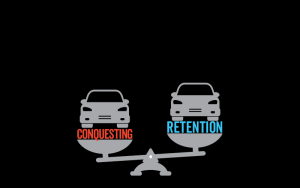You know what’s easier than finding new customers? Getting people who are already interested in your business to become customers. And one of the best ways to do this is with a retargeting campaign.
So what exactly is a retargeting campaign, and how can you get started? Get ready to breathe a sigh of relief, because it’s much easier than it sounds. Essentially, a retargeting campaign is a series of advertisements that are directed toward people who have already expressed an interest in your products or services.
Retargeting works by dropping a cookie (a tiny piece of data that is embedded into a user’s browser) on users that visit your site, allowing it to follow the user around as they visit other websites. Then, the retargeting cookie will enable your ads to be show on those sites encouraging the user to go back to your site.
The difference between retargeting and remarketing is the mechanism used to get users back to your site. With retargeting, a cookie is placed, and serves ads. With remarketing the mechanism to get users back to your site is usually email – collecting users emails and following up with a drip campaign.
Since we are talking retargeting, let’s focus on that. As with any kind of ad campaign, there are a few things you’ll need to keep in mind. Don’t worry, these five tips will help give you the knowledge foundation you need to set up retargeting campaigns that actually work.
Align your business goal to a retargeting goal
You always want to be able to measure your success, and setting a goal is a great way to do it. There are two major kinds of goals related to retargeting campaigns: Awareness and Conversion.
Awareness ads mainly focus on letting people know what products and services you have available. Your goal isn’t necessarily to sell something to them, it’s just to get them to start thinking about what you can offer.
Conversion ads aren’t actually about making sales – not all the time, anyway. Instead, their main purpose is to draw people deeper into your sales funnel by encouraging them to take the next step, whether that’s providing more information about themselves, downloading a free ebook, or doing whatever else you’d like them to do.
Most retargeting campaigns will do both of these, although Conversion ads tend to provide the best return on your investment. Ensure this goal aligns with one of your business and marketing goals – for example, if one of your marketing goals is brand visibility, an awareness goal would be the way to go.
TARGET PEOPLE CORRECTLY THE FIRST TIME
Not all visitors to your website are equal. Some will never become paying customers, no matter what you do, and it’s important to be able to sift through your visitors and figure out which ones are worth pursuing.
To do this, use software like Google Analytics and start building behavior profiles. Your goal is to figure out what a potential customer looks like on your site – that is, what they actually do while they’re present. If they only view one page and bounce off your site, they’re probably not worth pursuing. On the other hand, if they visited several informational pages but left afterwards, it might just be worth retargeting them.
The better you are at targeting people the first time around, the better your retargeting campaigns will become. Makes sense, right

GET YOUR FACTS RIGHT THE FIRST TIME
As part of correctly targeting people, you’ll also want to get as much information about them as you can – including an email address. When you have this, you can retarget more effectively (and in more places), drastically increasing your overall success rate.
That said, websites don’t just get email addresses – acquiring them needs to be a part of your site’s overall design if you’re going to get enough to make retargeting worthwhile. If you’re not currently doing that, you should consider a website redesign that can add this functionality.
SET YOUR BUDGET
When you sit down to create your budget, consider each portion of the campaign and how much each part is expected to cost. It’s ok to start with a very broad, all-inclusive plan and then work to narrow down the list afterwards.
If you can’t fund everything you want to do (and this happens more often than any of us would like), just trim down the parts offering the lowest return on your investment, or consider retargeting fewer people.
TEST AND MODIFY
The work isn’t done once your campaigns are set up! We could do a whole blog post on testing and optimizing. But in short, you’ll need to test the ads – and keep testing them on a regular basis – to find out which images, headlines, and descriptions are the best at converting people.
Successfully creating retargeting ads requires a different sort of expertise than most types of marketing. If you’re concerned about getting it right, our team at Ironmark can provide the creative expertise you need to maximize the success of your retargeting ads. Contact us today and one of our experts can get the process started.




